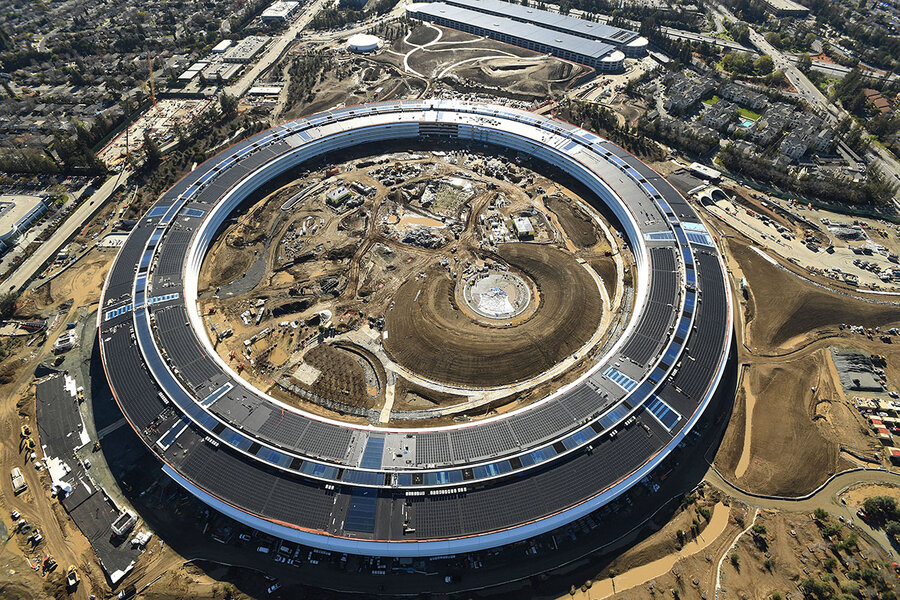Apple's new 'spaceship' campus a fitting tribute to Steve Jobs's obsessions
Loading...
The move-in date for Apple’s futuristic new Cupertino, Calif., campus in will likely be in the spring, people involved with the project told Reuters.
But the only fingerprints on the building, which resembles a circular spaceship, are those of the late Steve Jobs. Since Apple unveiled plans for the campus in 2011, workers often had to wear gloves to avoid marring the delicate building materials, which include the world’s largest piece of curved glass.
This attention to detail that Apple demanded of its construction workers, managers, architects, and others offers a window into the compulsive habits of the company and its founder, Mr. Jobs, which has driven its success. From perfectly flat doorways with no thresholds to unseen pipes and wiring, Apple required flawlessness in every aspect of the project. But treating a 2.8-million-square-foot complex like a 5-inch iPhone frustrated many of those brought in for the build, who said it enhanced the final product but clashed with construction realities.
"With phones, you can build to very, very minute tolerances," a former architect told Reuters, referring to the distance materials deviate from desired measurements. "You would never design to that level of tolerance on a building. Your doors would jam," he said. While the industry standard for tolerance is about one-eighth of an inch, many of Apple's standards for the building were even smaller.
After a lengthy approval process with the city, the complex, originally known as Apple 2, will be completed two years after Jobs’s initial projections. When Jobs unveiled plans for the campus months before his death in October 2011, the company’s founders said it should be finished by 2015.
But when it’s done, the campus will be an architectural feat. Along with the curved piece of glass, the sheer size of the complex will make it one of the largest office buildings in the world, according to Fortune. It will house up to 14,200 employees, according to a 2013 description. The main building will be surrounded by a canopy of thousands of trees, and the complex will also include a research and development center and an auditorium for product announcements. Former project managers estimate the price tag is about $5 billion, a number Apple Chief Executive Tim Cook did not dispute in a 2015 television interview.
The complex also represents a departure for the how the tech world treats its headquarters and office spaces. For one, generic office parks have allowed tech companies to lease and forgo office space through booms and busts. And the architectural trend is radically open offices aimed at fostering collaboration, Louise Mozingo, a professor and chair of the Department of Landscape Architecture and Environmental Planning at the University of California, Berkeley, told Reuters.
"[This complex is] not about maximizing the productivity of the office space, it's about creating a symbolic center for this global company," she said. "They are creating an icon."
Architect German de la Torre, who worked on the project, adds that much of the building resembles Apple products themselves, something he says has less to do with replicating Apple products and more with its executives’ ode to ideal form and dimension.
"They have arrived at design principles somehow through many years of experimentation, and they are faithful to those principles," Mr. de la Torre said.
But critics have criticized the aspirations of the complex. In 2013, Christopher Hawthorne of the Los Angeles Times wrote the campus "keeps itself aloof from the world around it to a degree that is unusual even in a part of California dominated by office parks. The proposed building is essentially one very long hallway connecting endlessly with itself."
But what the building will bring to Cupertino likely has the city excited.
"With the completion of Apple Campus 2, Apple salaries in Cupertino are expected to approximate $2.9 billion, with up to $1.8 billion accruing to employees who reside within Santa Clara County," reads a report from Keyser Marston. "Including indirect and induced impacts, Apple will generate $3.9 billion of employee compensation in Santa Clara County. Employee compensation translates directly into investment in local communities through expenditures on retail goods, housing, services, and entertainment."
Aerial footage of the complex was released last month by Matthew Roberts, a documentarian who has been flying a drone over the campus to watch its progress.
This report includes material from Reuters.







